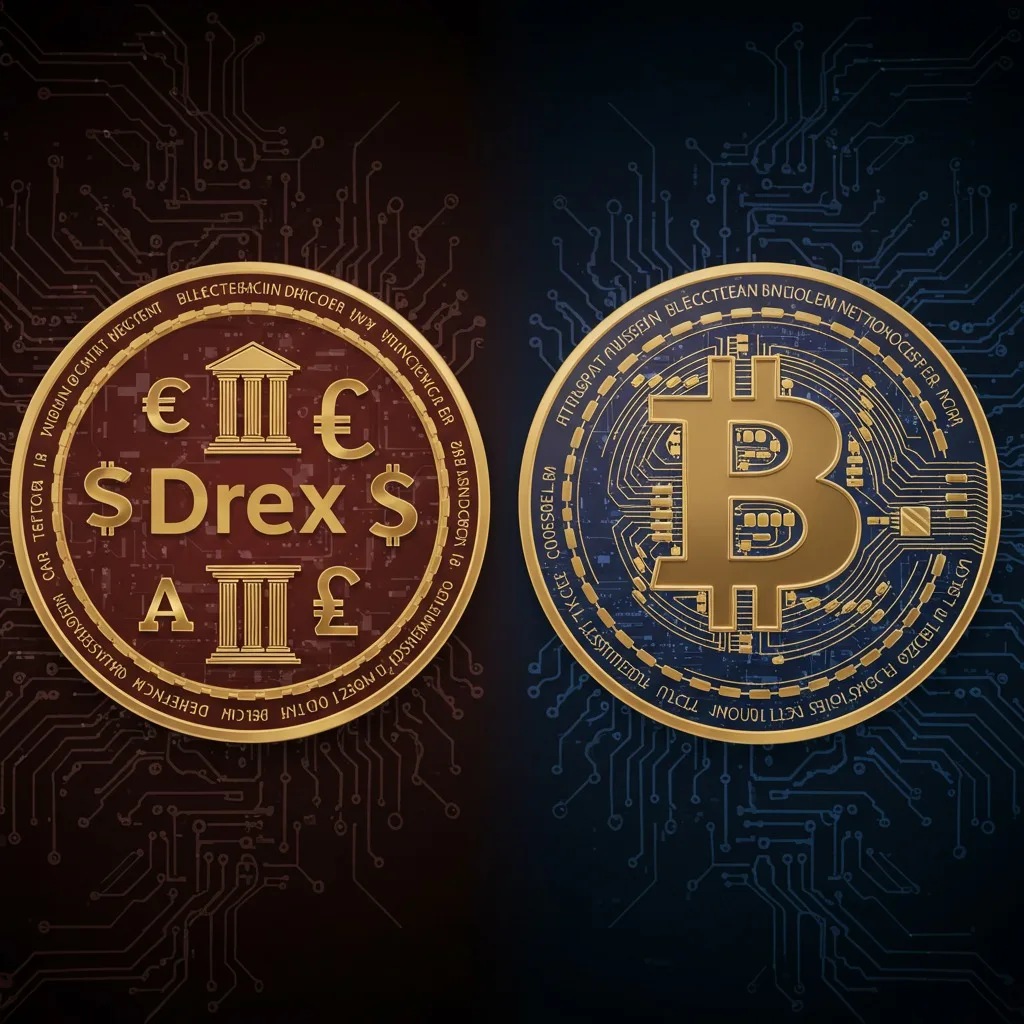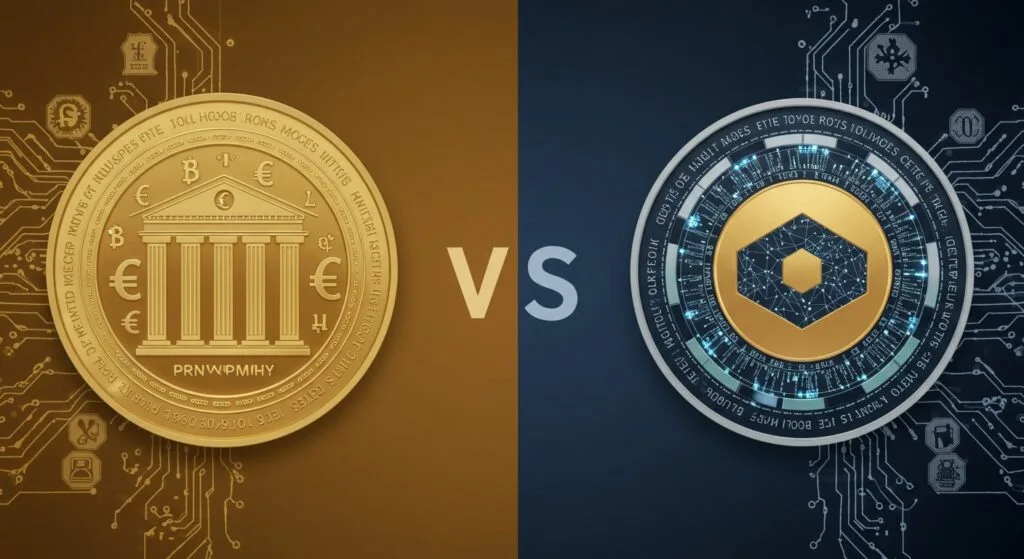The distinction between cryptocurrencies and digital currencies has sparked numerous questions in today’s financial landscape. After all, both represent forms of digital money, but their characteristics and implications are distinct. As the economy becomes increasingly digital, it’s crucial to understand the various forms of digital money emerging. This will enable us to make more informed decisions about investments, transactions, and the future of money.
So, prepare for an informative journey that will demystify the difference between cryptocurrencies and digital currencies, equipping you to navigate confidently in this ever-evolving universe.
Table of Contents

Understanding the Nature of Cryptocurrencies: Exploring Decentralization and Blockchain Technology
Cryptocurrencies like Bitcoin and Ethereum are decentralized digital currencies that operate independently of central authorities, such as governments and banks. This decentralization is one of their core pillars, providing greater autonomy to users.
Moreover, blockchain technology, a public and immutable ledger that records all transactions, ensures transparency and security. Each transaction is grouped into a block, which is cryptographically linked to the previous block, forming a chain (blockchain).
Thus, the difference between cryptocurrencies and digital currencies begins in their very essence: decentralization versus centralization. The blockchain ensures that transactions are verified by a network of computers, making them virtually tamper-proof.
Decoding Digital Currencies: A Focus on Centralized Control
In contrast to cryptocurrencies, digital currencies, also known as Central Bank Digital Currencies (CBDCs), are issued and controlled by central monetary authorities. For instance, the U.S. Federal Reserve has been exploring the idea of a digital dollar, aiming to modernize the financial system.
These digital currencies represent a digital version of traditional fiat money, such as the dollar, euro, or pound. They are regulated and supervised by governments, ensuring stability and reliability within the established financial system.
Therefore, the difference between cryptocurrencies and digital currencies lies in control: while cryptocurrencies are decentralized, digital currencies are centralized, which directly impacts how they operate and are regulated.
Underlying Technologies: Blockchain vs. Traditional Systems
As previously mentioned, blockchain technology is the backbone of cryptocurrencies. Its decentralized and transparent nature ensures the security and immutability of transactions.
On the other hand, digital currencies typically rely on centralized systems, similar to those used by traditional banks. These systems are efficient at processing large volumes of transactions, but they depend on trust in the central authority.
Consequently, the difference between cryptocurrencies and digital currencies is also evident in the technologies that support them. Blockchain offers a new paradigm of distributed trust, while traditional systems rely on trusted intermediaries.
Security and Privacy: Two Sides of the Same Coin (Literally)
Cryptocurrencies offer a degree of anonymity in transactions, although they are not fully anonymous. Security is guaranteed through encryption and the distributed nature of the blockchain.
Digital currencies, being controlled by central authorities, offer less privacy, as transactions can be traced by the government. However, government regulation can offer better protection against fraud and illicit activities.
Thus, the difference between cryptocurrencies and digital currencies extends to security and privacy issues. Each type of currency offers a different balance between these two aspects.
Volatility and Stability: Impacts on Value and Use
Volatility is a defining characteristic of cryptocurrencies. Their prices can fluctuate dramatically in short periods, influenced by market supply and demand.
In contrast, digital currencies, being tied to fiat currencies, maintain a relatively stable value. This stability makes them more suitable for everyday transactions.
Thus, the difference between cryptocurrencies and digital currencies also reflects the stability of their values. The volatility of cryptocurrencies makes them more attractive for speculative investments, while the stability of digital currencies makes them more suitable as a medium of exchange.
Regulation and the Future of the Digital Financial Landscape
The regulation of cryptocurrencies is still a hot topic in many countries. The lack of clear regulatory frameworks can create uncertainty and risk for investors.
On the other hand, digital currencies, being issued by central banks, already follow existing regulations. The regulation aims to ensure the security and stability of the financial system.
Therefore, the difference between cryptocurrencies and digital currencies is also seen in the regulatory sphere. Cryptocurrency regulation is an ongoing challenge, while digital currencies are already embedded in the existing regulatory framework.

Use Cases and Practical Applications
Cryptocurrencies have various applications, such as investments, online payments, international remittances, and the development of decentralized applications (dApps).
Digital currencies, in turn, are more focused on facilitating digital payments, reducing transaction costs, and promoting financial inclusion.
Consequently, the difference between cryptocurrencies and digital currencies is also reflected in their use cases. Cryptocurrencies offer a broader range of possibilities, while digital currencies focus on optimizing the traditional financial system.
To Remember: Final Insights
In summary, the difference between cryptocurrencies and digital currencies primarily lies in control, technology, and stability.
- Cryptocurrencies are decentralized, use blockchain technology, and are volatile.
- Digital currencies are centralized, use traditional systems, and are stable.
- Both represent advancements in the financial system, with distinct applications and purposes.
- Understanding these differences is crucial to navigating the digital financial landscape.

Here’s a Quick Comparison Table:
| Aspect | Cryptocurrencies | Digital Currencies (CBDCs) |
|---|---|---|
| Control | Decentralized | Centralized (governments/central banks) |
| Technology | Primarily Blockchain | May use blockchain or other systems |
| Regulation | Little to none | Heavily regulated |
| Transparency | Public (depending on the coin) | Traceable by the government, limited to the public |
| Stability | Volatile | Stable (pegged to fiat currency) |
| Privacy | Depends on the coin, higher anonymity possible | Potential for surveillance, lower privacy |
| Security | Encryption, distributed network | Depends on central bank infrastructure |
| Issuance | Mining, staking, etc. | Issued by central bank |
| Use Cases | Investments, payments, DeFi, NFTs, etc. | Digital payments, financial inclusion |
Now that you understand the difference, quickly answer: What’s Your Profile in the Digital World?
- You primarily seek:
a. Investments with high potential returns, even with higher risk.
b. Ease and security in everyday transactions. - You feel more comfortable with:
a. Innovative, decentralized technologies.
b. Traditional, regulated financial systems. - Your priority regarding privacy is:
a. Greater anonymity in transactions.
b. Greater security against fraud, even with less privacy.
Based on your answers, you may have an idea of which type of digital currency aligns best with your needs and preferences.
I hope this article has clarified the difference between cryptocurrencies and digital currencies. If you have any further questions, feel free to reach out!
Want to take your financial knowledge even further? 📚💡 Check out our other posts for expert insights, practical tips, and strategies to help you build a secure and prosperous financial future. Explore More Now!
- Caixa Launches Fun Money Game on Roblox
- Easy Ways to Get Robux in Roblox
- Get Free Roblox Items This March
- How to Earn Free Robux Online
- 🍔 Why McDonald’s Became a “Luxury Meal”: The Real Reason Behind the Prices (And How to Beat Them in 2025)
